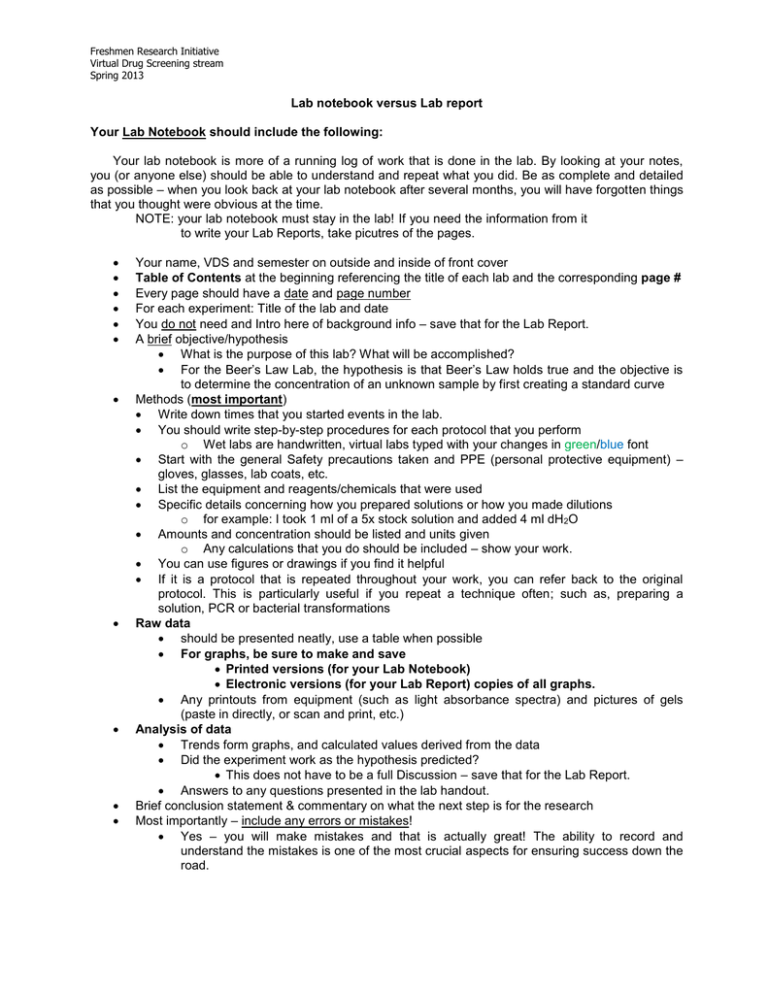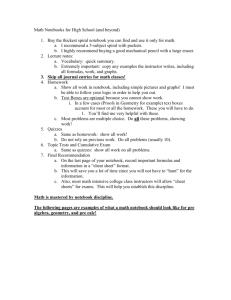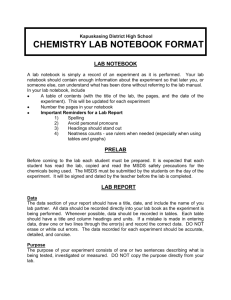Lab notebook versus Lab report
advertisement

Freshmen Research Initiative Virtual Drug Screening stream Spring 2013 Lab notebook versus Lab report Your Lab Notebook should include the following: Your lab notebook is more of a running log of work that is done in the lab. By looking at your notes, you (or anyone else) should be able to understand and repeat what you did. Be as complete and detailed as possible – when you look back at your lab notebook after several months, you will have forgotten things that you thought were obvious at the time. NOTE: your lab notebook must stay in the lab! If you need the information from it to write your Lab Reports, take picutres of the pages. Your name, VDS and semester on outside and inside of front cover Table of Contents at the beginning referencing the title of each lab and the corresponding page # Every page should have a date and page number For each experiment: Title of the lab and date You do not need and Intro here of background info – save that for the Lab Report. A brief objective/hypothesis What is the purpose of this lab? What will be accomplished? For the Beer’s Law Lab, the hypothesis is that Beer’s Law holds true and the objective is to determine the concentration of an unknown sample by first creating a standard curve Methods (most important) Write down times that you started events in the lab. You should write step-by-step procedures for each protocol that you perform o Wet labs are handwritten, virtual labs typed with your changes in green/blue font Start with the general Safety precautions taken and PPE (personal protective equipment) – gloves, glasses, lab coats, etc. List the equipment and reagents/chemicals that were used Specific details concerning how you prepared solutions or how you made dilutions o for example: I took 1 ml of a 5x stock solution and added 4 ml dH2O Amounts and concentration should be listed and units given o Any calculations that you do should be included – show your work. You can use figures or drawings if you find it helpful If it is a protocol that is repeated throughout your work, you can refer back to the original protocol. This is particularly useful if you repeat a technique often; such as, preparing a solution, PCR or bacterial transformations Raw data should be presented neatly, use a table when possible For graphs, be sure to make and save Printed versions (for your Lab Notebook) Electronic versions (for your Lab Report) copies of all graphs. Any printouts from equipment (such as light absorbance spectra) and pictures of gels (paste in directly, or scan and print, etc.) Analysis of data Trends form graphs, and calculated values derived from the data Did the experiment work as the hypothesis predicted? This does not have to be a full Discussion – save that for the Lab Report. Answers to any questions presented in the lab handout. Brief conclusion statement & commentary on what the next step is for the research Most importantly – include any errors or mistakes! Yes – you will make mistakes and that is actually great! The ability to record and understand the mistakes is one of the most crucial aspects for ensuring success down the road. Freshmen Research Initiative Virtual Drug Screening stream Spring 2013 Lab notebook versus Lab report Your Lab Report should be: Your lab report is a descriptive narrative of what you did. It should be a typewritten document. Be concise and use good grammar. There should be less detail than what is in the Notebook, but enough to show that you understand the work. Don’t use 1st person Use third person e.g. NOT ‘I added the solution’ but rather “the solution was added” Use paste tense – almost all of the time. e.g. NOT ‘the data is increasing linearly over time’ but rather ‘ the date increase linearly over time” 1. Your name, lab title, and date. The title should not be more than 12 words long and should reflect the effect of the independent variable upon the dependent variable Do not use the title that was given in the handout. 2. Objective/Introduction Why did you do the lab? What were you trying to show? Use this space to give a brief intro of the technique or procedure in general – what it is used for and why it is important. How does this lab fit into the overall context of virtual drug screening? Give some background information that is useful (this can be obtained from outside sources). If you are are trying to answer a hypothesis – specifically state it here. Please use your own words – do not just copy text from the handout. You may paraphrase parts that are necessary. 3. Materials & Methods This is a section describing what methods you used in the lab – but does not include any Data! It should be written as a descriptive paragraph and not a bulleted list. Do not simply copy the procedure from the lab handout. Exclude minutiae or extraneous detail that is not useful. Include safety precautions taken. Since it describes what you did, it should be written in the past tense. For special items (equipment or non-common reagents) list the product names (Company Name, City, State). E.g. Red Tide Spectrophotometer (Ocean Optics, Dunedin, FL) 4. Results & Discussion Your data and any observations made while performing the experiment are included here. First state your results in a factual manner. Then analyze them and discuss the findings. Essentially, you want to point out what the reader should see on the graphs and tables and then say why the data is the way it is. Mention your ‘sources of error’ – what went wrong and how you would correct them next time Results should include: graphs, images, tables, copies of spectra, and pictures of gels. Include proper units and labels for all axes of graphs Use descriptive captions to tell what has been done so that it is easy to interpret i. For figures, captions should go underneath figures ii. For tables, captions should go above the table. Once you have addressed each of your results alone, then discuss the work as a whole. i. What do your findings mean when taken together? ii. What do your results mean in the context of our research as a whole? 5. Conclusions – Briefly re-cap what was done in this lab, state a conclusion and make a statement about what the next step would be after this experiment – or what this experiment allows you to do now. 6. References - include numbered bibliography in ACS (American Chemical Society) format When citing a reference include citation [in brackets] in the body of your paper [2]. Put your name and assignment name in header of each page. Format for submission of assignments: YourUTEID_YourName_Date_Assignment.pdf








